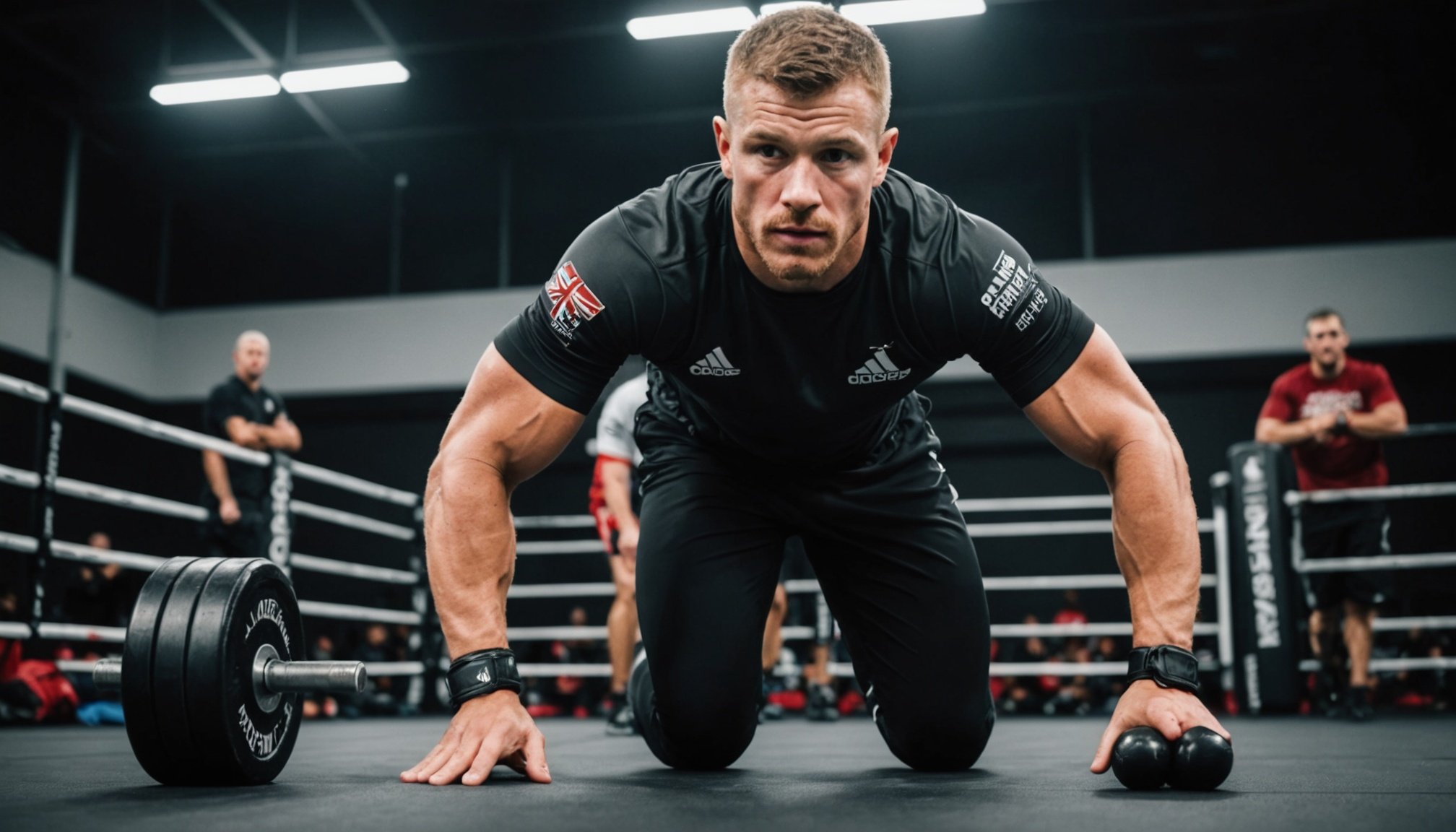Importance of Joint Mobility in Combat Sports
Joint mobility is a crucial aspect of combat sports, integral not only for athletic performance but also for injury prevention. In sports such as MMA, boxing, and judo, where repetitive and high-impact movements are common, the ability to move joints through their full range of motion without restriction is paramount.
Improved joint mobility enhances athletic performance by allowing athletes to move more freely and efficiently, facilitating quicker reactions and more precise techniques. In combat sports, fluid and unrestricted movements can be the difference between winning and losing. Furthermore, well-conditioned joints help absorb and distribute forces, reducing the risk of common injuries like sprains, strains, and even dislocations.
Also read : Maximize your kickboxing strength: the ultimate resistance band guide for uk fighters
Statistical insights indicate a significant correlation between joint mobility and injury rates in combat sports: athletes with greater joint mobility often experience fewer injuries. This makes sense, as flexible joints are better able to withstand the rigors of intense physical activity, reducing the likelihood of wear and tear. Ultimately, prioritising joint mobility not only boosts performance but also extends an athlete’s career, permitting them to train and compete safely for longer periods.
Common Joint Issues for Combat Athletes
Combat sports demand intense physical effort, often leading to prevalent joint issues. Knees, shoulders, and wrists are particularly vulnerable due to repetitive striking, grappling, or sudden impacts. Such injuries in combat athletes are not uncommon, reflecting the high-risk nature of these sports.
Also read : Unleashing your inner champion: the complete uk boxer”s handbook to speed bag mastery
Several factors escalate the injury risk. The high-impact nature of movements like punches and kicks puts immense stress on the joints. Furthermore, intense training schedules and lack of adequate recovery exacerbate the situation, making joint problems a frequent hurdle for athletes.
Limited mobility due to joint issues significantly impacts an athlete’s performance. In such a competitive field, even slight joint discomfort can hinder one’s ability to execute moves effectively. This restriction not only affects day-to-day training but also compromises competition readiness.
Combat athletes must adopt preventive measures and address early signs of joint trouble to sustain their careers. Regular conditioning, proper technique, and timely rest could help mitigate these issues. Ensuring joint health is paramount to maintaining peak performance in combat sports, as it safeguards against prolonged injury risk and ensures longevity in their athletic pursuits.
Effective Mobility Exercises for Combat Sports
Improving joint flexibility and overall mobility is crucial for athletes engaged in combat sports. Mobility exercises are designed to enhance performance and reduce injury risks by focusing on critical joints.
Dynamic Warm-up Routines
Dynamic stretching should be a staple in any athletic training plan. Engaging in these routines pre-competition helps prepare the body for intense activity by elevating muscle temperature and increasing blood flow. Core exercises often involve the hips, shoulders, and ankles. For instance, leg swings and arm circles are excellent for loosening up the hip and shoulder areas, promoting a greater range of motion and minimizing injury risks.
Static Stretching Techniques
Post-training recovery can be significantly improved with static stretching. This technique involves holding a stretch for 15-60 seconds, aiding muscle relaxation and lengthening. Effective stretches include the hamstring stretch, quad stretch, and gentle neck stretches. These practices not only foster recovery but also enhance flexibility over time, allowing for more efficient athletic performance.
Joint-Specific Mobility Drills
Focusing on specific joints like the knee, elbow, and wrist through targeted mobility drills is advisable. Examples include wrist circles and knee flexion/extension movements. Regular incorporation of these exercises into training sessions ensures athletic training routines remain comprehensive and tailored to combat sports’ unique demands.
Nutrition for Joint Health
Understanding how nutrition contributes to joint health is essential, especially for those engaged in combat sports. Key nutrients, such as Omega-3 fatty acids and glucosamine, play a vital role in maintaining healthy joints. These nutrients help reduce inflammation and maintain the integrity of cartilage, a crucial component for mobility and flexibility.
In terms of a combat sports diet, athletes should focus on incorporating foods rich in these nutrients. For instance, fatty fish like salmon and mackerel are excellent sources of Omega-3s, while supplements or shellfish can provide glucosamine. Additionally, incorporating vegetables and fruits rich in Vitamin C can aid collagen synthesis, strengthening joint tissues.
Hydration cannot be overlooked when considering joint health. During intense training sessions, sufficient hydration ensures the lubrication of joints and prevention of injuries. This is crucial because dehydration can lead to a decrease in synovial fluid, which acts as a lubricant for joint surfaces, potentially increasing friction and wear on the joints.
In summary, a well-rounded combat sports diet, rich in Omega-3s, glucosamine, and adequate hydration, can significantly enhance joint function and overall performance. Adopting these dietary choices ensures athletes maintain optimal mobility and reduce the risk of injury.
Expert Insights on Enhancing Joint Mobility
Improving joint mobility is vital for athletes, especially in combat sports, where agility and flexibility can be game-changers. Let’s dive into expert advice and insights from specialists in this field.
Physical therapists who focus on combat sports frequently emphasize mobility enhancement. For example, Dr. Rachel Ingalls, a renowned physical therapist, mentions, “Incorporating dynamic stretches and strength-building exercises into routine training can significantly enhance joint flexibility, reducing injury risks while boosting performance.” This perspective is supported by research findings that highlight how tailored joint mobility programs greatly benefit athletes in combat sports.
Athlete success stories are a testament to the efficacy of these recommendations. Take, for instance, John Mason, a mixed martial artist who transformed his career by focusing on mobility work. John’s dedication to mobility-enhancing routines, crafted by combat sports specialists, led to significant improvements in both his performance and overall health.
The science behind joint mobility programs designed for athletes in combat sports is well-documented. Researchers indicate increased joint range of motion and reduced recovery time as key outcomes. Whether you’re an athlete yourself or a dedicated fan of combat sports, understanding the importance of joint mobility can empower you to make informed choices about athletic training.
Developing a Personalized Mobility Program
Creating a tailored mobility program is crucial for effective athlete development. To achieve optimal results, it starts with a comprehensive understanding of each athlete’s unique condition. Identifying personal needs ensures training is both relevant and effective.
Assessing Individual Needs
Conducting mobility assessments is vital for athletes. These assessments highlight personal joint limitations, guiding the setting of realistic goals. Understanding these limitations allows for crafting a program that specifically addresses the athlete’s requirements.
Structuring Your Mobility Routine
A structured mobility routine considers both the frequency and duration necessary for improvement. Training should typically be incorporated into the athlete’s schedule, allowing for consistent progress. Rest and recovery are equally important elements, ensuring the body has time to regenerate and respond positively to training stimuli.
Monitoring Progress and Adjusting Techniques
Regular progress monitoring offers insights into an athlete’s improvement in mobility and performance. By tracking changes, athletes can see tangible results, which is motivating. Channeling feedback into practice and adjusting techniques or intensity is essential based on performance outcomes. A flexible approach will help in maintaining a progressive and effective routine. Emphasizing adaptability ensures that the program evolves with the athlete’s development.











